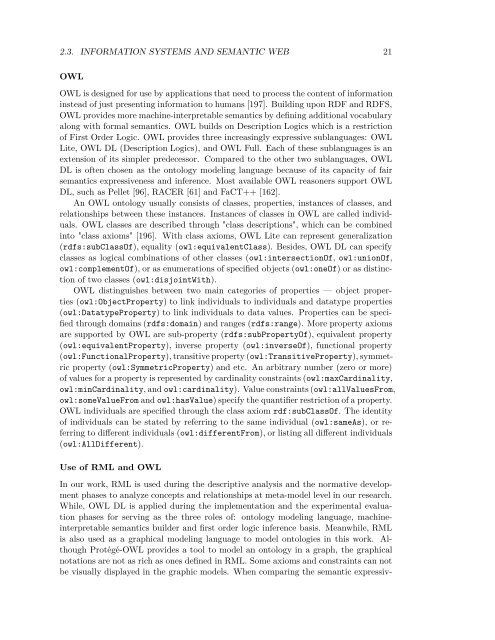Semantic Annotation for Process Models: - Department of Computer ...
Semantic Annotation for Process Models: - Department of Computer ...
Semantic Annotation for Process Models: - Department of Computer ...
You also want an ePaper? Increase the reach of your titles
YUMPU automatically turns print PDFs into web optimized ePapers that Google loves.
2.3. INFORMATION SYSTEMS AND SEMANTIC WEB 21<br />
OWL<br />
OWL is designed <strong>for</strong> use by applications that need to process the content <strong>of</strong> in<strong>for</strong>mation<br />
instead <strong>of</strong> just presenting in<strong>for</strong>mation to humans [197]. Building upon RDF and RDFS,<br />
OWL provides more machine-interpretable semantics by defining additional vocabulary<br />
along with <strong>for</strong>mal semantics. OWL builds on Description Logics which is a restriction<br />
<strong>of</strong> First Order Logic. OWL provides three increasingly expressive sublanguages: OWL<br />
Lite, OWL DL (Description Logics), and OWL Full. Each <strong>of</strong> these sublanguages is an<br />
extension <strong>of</strong> its simpler predecessor. Compared to the other two sublanguages, OWL<br />
DL is <strong>of</strong>ten chosen as the ontology modeling language because <strong>of</strong> its capacity <strong>of</strong> fair<br />
semantics expressiveness and inference. Most available OWL reasoners support OWL<br />
DL, such as Pellet [96], RACER [61] and FaCT++ [162].<br />
An OWL ontology usually consists <strong>of</strong> classes, properties, instances <strong>of</strong> classes, and<br />
relationships between these instances. Instances <strong>of</strong> classes in OWL are called individuals.<br />
OWL classes are described through "class descriptions", which can be combined<br />
into "class axioms" [196]. With class axioms, OWL Lite can represent generalization<br />
(rdfs:subClassOf), equality (owl:equivalentClass). Besides, OWL DL can specify<br />
classes as logical combinations <strong>of</strong> other classes (owl:intersectionOf, owl:unionOf,<br />
owl:complementOf), or as enumerations <strong>of</strong> specified objects (owl:oneOf) or as distinction<br />
<strong>of</strong> two classes (owl:disjointWith).<br />
OWL distinguishes between two main categories <strong>of</strong> properties — object properties<br />
(owl:ObjectProperty) to link individuals to individuals and datatype properties<br />
(owl:DatatypeProperty) to link individuals to data values. Properties can be specified<br />
through domains (rdfs:domain) and ranges (rdfs:range). More property axioms<br />
are supported by OWL are sub-property (rdfs:subPropertyOf), equivalent property<br />
(owl:equivalentProperty), inverse property (owl:inverseOf), functional property<br />
(owl:FunctionalProperty), transitive property (owl:TransitiveProperty), symmetric<br />
property (owl:SymmetricProperty) and etc. An arbitrary number (zero or more)<br />
<strong>of</strong> values <strong>for</strong> a property is represented by cardinality constraints (owl:maxCardinality,<br />
owl:minCardinality, and owl:cardinality). Value constraints (owl:allValuesFrom,<br />
owl:someValueFrom and owl:hasValue) specify the quantifier restriction <strong>of</strong> a property.<br />
OWL individuals are specified through the class axiom rdf:subClassOf. The identity<br />
<strong>of</strong> individuals can be stated by referring to the same individual (owl:sameAs), or referring<br />
to different individuals (owl:differentFrom), or listing all different individuals<br />
(owl:AllDifferent).<br />
Use <strong>of</strong> RML and OWL<br />
In our work, RML is used during the descriptive analysis and the normative development<br />
phases to analyze concepts and relationships at meta-model level in our research.<br />
While, OWL DL is applied during the implementation and the experimental evaluation<br />
phases <strong>for</strong> serving as the three roles <strong>of</strong>: ontology modeling language, machineinterpretable<br />
semantics builder and first order logic inference basis. Meanwhile, RML<br />
is also used as a graphical modeling language to model ontologies in this work. Although<br />
Protégé-OWL provides a tool to model an ontology in a graph, the graphical<br />
notations are not as rich as ones defined in RML. Some axioms and constraints can not<br />
be visually displayed in the graphic models. When comparing the semantic expressiv-
















